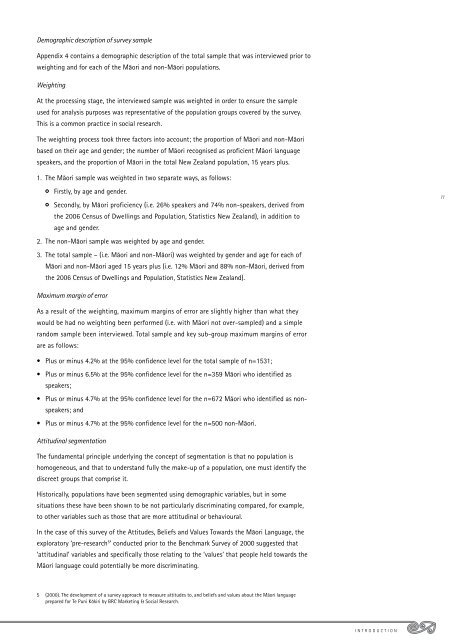2009 Survey of Attitudes, Values and Beliefs ... - Te Puni Kokiri
2009 Survey of Attitudes, Values and Beliefs ... - Te Puni Kokiri
2009 Survey of Attitudes, Values and Beliefs ... - Te Puni Kokiri
Create successful ePaper yourself
Turn your PDF publications into a flip-book with our unique Google optimized e-Paper software.
Demographic description <strong>of</strong> survey sample<br />
Appendix 4 contains a demographic description <strong>of</strong> the total sample that was interviewed prior to<br />
weighting <strong>and</strong> for each <strong>of</strong> the Mäori <strong>and</strong> non-Mäori populations.<br />
Weighting<br />
At the processing stage, the interviewed sample was weighted in order to ensure the sample<br />
used for analysis purposes was representative <strong>of</strong> the population groups covered by the survey.<br />
This is a common practice in social research.<br />
The weighting process took three factors into account; the proportion <strong>of</strong> Mäori <strong>and</strong> non-Mäori<br />
based on their age <strong>and</strong> gender; the number <strong>of</strong> Mäori recognised as pr<strong>of</strong>icient Mäori language<br />
speakers, <strong>and</strong> the proportion <strong>of</strong> Mäori in the total New Zeal<strong>and</strong> population, 15 years plus.<br />
1. The Mäori sample was weighted in two separate ways, as follows:<br />
Firstly, by age <strong>and</strong> gender.<br />
Secondly, by Mäori pr<strong>of</strong>iciency (i.e. 26% speakers <strong>and</strong> 74% non-speakers, derived from<br />
the 2006 Census <strong>of</strong> Dwellings <strong>and</strong> Population, Statistics New Zeal<strong>and</strong>), in addition to<br />
age <strong>and</strong> gender.<br />
2. The non-Mäori sample was weighted by age <strong>and</strong> gender.<br />
3. The total sample – (i.e. Mäori <strong>and</strong> non-Mäori) was weighted by gender <strong>and</strong> age for each <strong>of</strong><br />
Mäori <strong>and</strong> non-Mäori aged 15 years plus (i.e. 12% Mäori <strong>and</strong> 88% non-Mäori, derived from<br />
the 2006 Census <strong>of</strong> Dwellings <strong>and</strong> Population, Statistics New Zeal<strong>and</strong>).<br />
11<br />
Maximum margin <strong>of</strong> error<br />
As a result <strong>of</strong> the weighting, maximum margins <strong>of</strong> error are slightly higher than what they<br />
would be had no weighting been performed (i.e. with Mäori not over-sampled) <strong>and</strong> a simple<br />
r<strong>and</strong>om sample been interviewed. Total sample <strong>and</strong> key sub-group maximum margins <strong>of</strong> error<br />
are as follows:<br />
• Plus or minus 4.2% at the 95% confidence level for the total sample <strong>of</strong> n=1531;<br />
• Plus or minus 6.5% at the 95% confidence level for the n=359 Mäori who identified as<br />
speakers;<br />
• Plus or minus 4.7% at the 95% confidence level for the n=672 Mäori who identified as nonspeakers;<br />
<strong>and</strong><br />
• Plus or minus 4.7% at the 95% confidence level for the n=500 non-Mäori.<br />
Attitudinal segmentation<br />
The fundamental principle underlying the concept <strong>of</strong> segmentation is that no population is<br />
homogeneous, <strong>and</strong> that to underst<strong>and</strong> fully the make-up <strong>of</strong> a population, one must identify the<br />
discreet groups that comprise it.<br />
Historically, populations have been segmented using demographic variables, but in some<br />
situations these have been shown to be not particularly discriminating compared, for example,<br />
to other variables such as those that are more attitudinal or behavioural.<br />
In the case <strong>of</strong> this survey <strong>of</strong> the <strong>Attitudes</strong>, <strong>Beliefs</strong> <strong>and</strong> <strong>Values</strong> Towards the Mäori Language, the<br />
exploratory ‘pre-research 5 ’ conducted prior to the Benchmark <strong>Survey</strong> <strong>of</strong> 2000 suggested that<br />
‘attitudinal’ variables <strong>and</strong> specifically those relating to the ‘values’ that people held towards the<br />
Mäori language could potentially be more discriminating.<br />
5 (2000). The development <strong>of</strong> a survey approach to measure attitudes to, <strong>and</strong> beliefs <strong>and</strong> values about the Mäori language<br />
prepared for <strong>Te</strong> <strong>Puni</strong> Kökiri by BRC Marketing & Social Research.<br />
I N T R O D U C T I O N

















